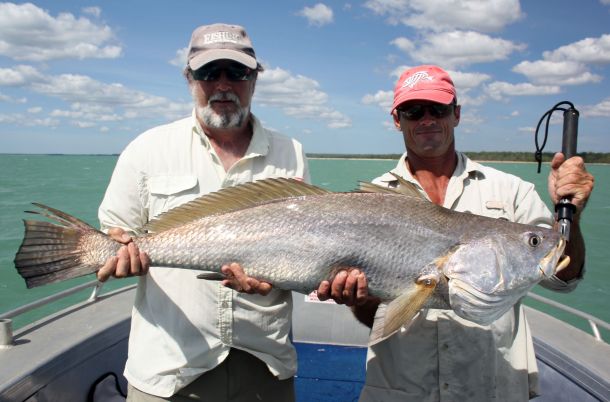BLACK jewfish (Protonibea diacanthus) once occurred in large numbers in estuaries and coastal waters throughout South East Asia as far west as India and the Arabian Gulf and as far north as Japan, but has today become rare in all of those places.
In the last stronghold in Northern Australia, large black jew are regarded as a prize capture by Aussie fishos who generally target them over inshore natural and artificial reefs using heavy tackle or handlines. Like the closely related southern jewfish, or mulloway (Argyrosomus hololepidotus), black jew are a member of the family Scianidae, which includes the croakers and drums. As for other members of the family, black jew can produce sounds using special muscles which utilise the swim bladder as an amplifier to produce various types of grunts and croaks. These might be used for communication or as an alarm signal to warn other fish in their school of danger.
Black jew grow to around 45 kg and 1.5 metres long, with a rapid growth rate, reaching 60 cm in around 2 years and maturity in around 4 years at 80-90 cm.
There are many populations of black jew in Australias northern waters, each with its own discreet spawning area to which fish are either resident year round, or return to year after year to spawn. Increased access, better fishing gear and GPS have allowed more effective fishing of these spawning aggregations in recent years, which in turn has prompted increased scientific interest in black jew biology. Acoustic tagging studies have now proven beyond doubt that populations of black jew aggregate in certain areas, and the behaviour of these fish suggests there can be even more than one separate population of fish at any given aggregation area. This sort of fascinating fish behaviour means that black jew are very vulnerable to localised depletion if overfishing of these spawning aggregations is allowed.
A case study of the usual process historically seen with management of black jew spawning aggregations occurred on the northwest coast of Cape York Peninsula. Here the Injinoo aboriginal community had fished for black jew over deep holes and trenches off rocky headlands for at least 50 years, reliably capturing large specimens up to 1.5 metres long all that time. However, in the late 1990s, they observed a marked decline in fish size and numbers. By the year 2000, researchers found the average size of black jew caught during the spawning aggregation had dropped to immature 60-70cm fish around 2 years old. The lack of mature black jew in the aggregation highlighted the stock was under threat, and immediate management action was taken by QLD Fisheries and the Injinoo people instigated a 2 year ban on black jew to allow the fishery to recover.
QLD Fisheries reacted to this new information by implementing a slot limit (min 60cm, max. 120 cm) and bag limit (5 per person, with no more than 2 over 100 cm) in the Gulf of Carpentaria. On QLDs east coast, however, a minimum size of 75cm and more appropriate bag of 2 fish per person was implemented.
The next problem that surfaced (literally) was confirmation that black jew taken from water deeper than around 10 metres are very vulnerable to barotrauma, which obviously complicates management matters even more as the survival of released fish could not be taken for granted. Fishers began to realise that to maximise black jew survival, they needed to adopt best practice methods of releasing fish, which in this case would be the use of large release weights to recompress undersized black jew, and avoidance of fishing for this species once the fisher had caught their bag limit (especially in areas where the water was deeper than 10 metres).
Alternative management arrangements that could be considered to protect black jew spawning aggregations include seasonal closures and /or small “no take” green zones specifically located to encompass the aggregation sites. While no take zones are controversial, the loss of access could be negated to some extent by keeping the zones small and establishing artificial reefs away from the natural spawning areas. These examples highlight the vulnerability of black jew to fishing on their spawning aggregations, and the range of management arrangements that may need to be implemented in a balanced way to protect their populations so that northern Australia remains a stronghold for black jew in the years ahead.

















